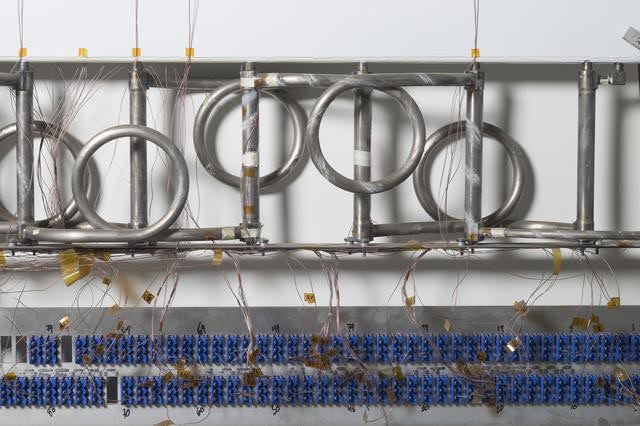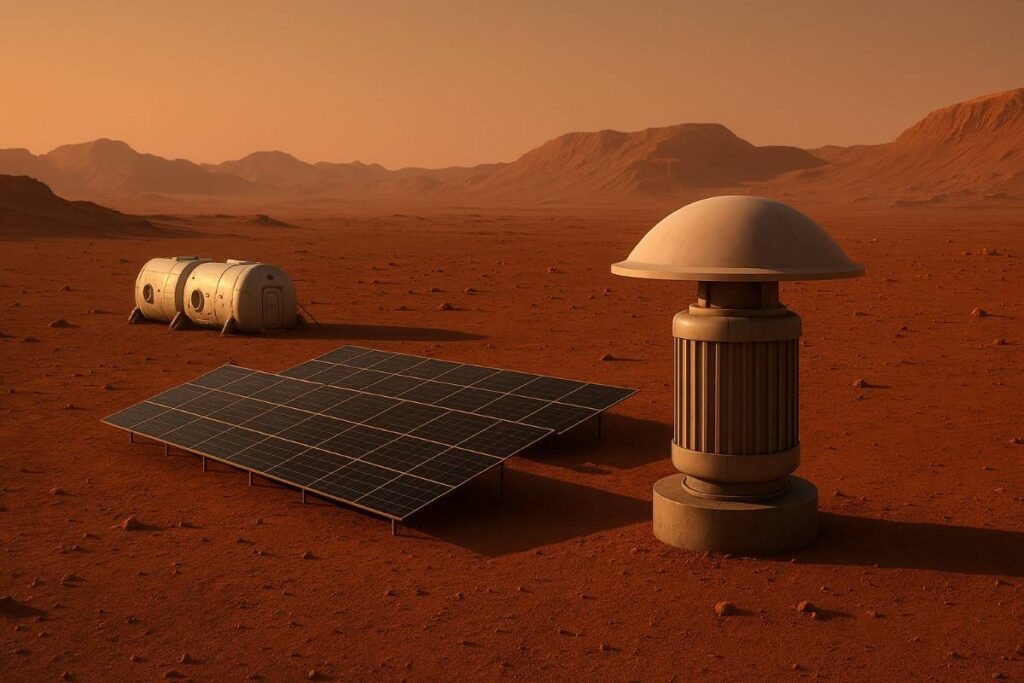Powering space mining isn’t a one-size-fits-all situation. Just as Earth requires different sources depending on the region, space necessitates unique solutions for various locations.
Let’s break down which energy sources work best for the Moon, Mars, and asteroids, and what that means for the future of space mining technology, companies, and the growing potential of resources in space.
Why Energy Sources Matter for Space Mining
Energy isn’t just needed for mining drills and processing tools. It’s the backbone of everything – from life support systems to communication and mobility. From regulating thermal systems in extreme environments to powering scientific instruments and maintaining connectivity with Earth, the demand for a stable energy supply is continuous.
For example, a lunar mining base would need power to keep equipment running through the two-week-long night, while Martian habitats require heating and air circulation in sub-zero conditions.
The farther we go into outer space, the more difficult it becomes to rely on Earth-based supply chains. Launching replacement batteries or fuel from Earth is costly and inefficient. That’s why sustainable, local power is essential. Systems need to be autonomous, repairable, and capable of surviving in harsh, remote environments.
More than a technical requirement, the choice of energy source also has larger implications. It’s about economic growth, reducing carbon dioxide emissions, and minimizing the environmental cost and social costs of our expanding space activities.
For instance, relying on solar and hydrogen fuel cells for operations in low-Earth orbit or on celestial bodies near the Sun could reduce the need to transport toxic fuels. As we begin to exploit resources in space, our approach to power generation will play a key role in ensuring that the benefits outweigh the drawbacks and contribute to a more responsible model of exploration.
The Moon: Reliable Solar and Scalable Nuclear

The Moon is a major target for near-term resource extraction and commercial activities. It’s close, has no atmosphere, and features known reserves of water ice and potentially precious metals deep within its crust. Because of its location and relatively stable environment, the Moon offers a practical testbed for developing long-term space mining technology.
Solar Power at the Lunar Poles
The lunar poles are among the most promising locations for deploying solar power infrastructure. Thanks to the Moon’s unique axial tilt, some peaks at the poles receive nearly continuous sunlight year-round. This makes them ideal spots for building space-based solar power systems. Solar panels placed on these high ridges could transmit electricity down to mining operations located in shadowed craters where water ice is preserved.
Companies like Astrobotic are developing power grids based on this concept. Meanwhile, Blue Origin is actively working on technologies like Blue Alchemist, which can turn lunar regolith into solar cells, enabling in-situ manufacturing of solar panels. This would create a self-sustaining supply chain for power, reducing dependence on Earth shipments and supporting long-term development of lunar industries. It’s a major step toward clean energy solutions beyond our planet.
Small-Scale Nuclear Reactors
Despite the potential of solar, it isn’t always sufficient. Parts of the Moon experience 14-day-long nights, and many mining targets lie in permanently shadowed regions. To overcome this, nuclear power has emerged as a reliable complement to solar.
NASA’s Fission Surface Power Project is already working on compact nuclear systems that can deliver 40kW of continuous energy. These reactors are being designed to operate autonomously for up to a decade with minimal maintenance, making them ideal for supporting mining outposts and robotic missions. Unlike solar, these systems aren’t affected by lunar dust, shadows, or night cycles.
Helium-3: A Long-Term Dream
The Moon is also considered a potential source of helium-3, a light isotope that could be used in fusion energy. While fusion is still under development on Earth, many scientists believe helium-3 could become a valuable fuel for a type of clean, high-output power in the future. Harvesting helium-3 from lunar regolith could create a new market for energy-rich resources in space.
Mars: Harsh Environment, Big Potential

Mars may be the long-term goal for human settlement, but when it comes to energy, the red planet is far from ideal. The planet is cold, has a thin atmosphere, and experiences massive dust storms that can blanket the surface for weeks, severely limiting the effectiveness of solar power. But, there still are some promising factors.
Nuclear is the Best Bet (for Now)
Because of the weak sunlight (only about 43% the intensity compared to Earth), nuclear power currently stands out as the most practical solution. Mars also shows signs of uranium mineralization in certain areas, especially around volcanic regions, potentially making it feasible to source nuclear fuel on-site in the future.
NASA’s Kilopower project, first introduced for the Moon, and other studies have shown that nuclear reactors provide the consistent power needed to maintain habitats, operate mining equipment, and run scientific laboratories during extended periods of low sunlight. These reactors are designed to be modular, scalable, and long-lasting.
Solar + Hydrogen Fuel Cells?
While solar alone isn’t enough, combining it with hydrogen fuel cells could offer a workaround. In areas where solar is feasible, energy collected during the day could power electrolyzers that split water into hydrogen and oxygen. This hydrogen could then be stored and used in fuel cells to generate electricity at night or during storms.
The limitation? Mars doesn’t have a lot of accessible water. Until we develop more efficient ways to extract water from Martian ice or soil, this option remains more theoretical than practical.
Deuterium
Interestingly, Mars is rich in deuterium, a form of hydrogen that could be used in fusion reactors. Though fusion technology is not yet viable, many experts consider it the holy grail of space energy systems. If realized, it could dramatically shift how we think about clean energy and resource extraction across the solar system.
Asteroids: Near-Sun Solar or Nuclear for the Belt
Some of the most valuable space resources available are asteroids, especially those rich in precious metals and earth metals. But energy strategies vary dramatically depending on where the asteroid is located.
NEAs: Solar is Still Viable
Near-Earth Asteroids (NEAs) are close enough to the Sun for solar energy to be a practical option. These missions can benefit from relatively short travel times, simpler energy systems, and efficient robotic operations.
Companies like Planetary Resources and Deep Space Industries have explored the idea of using solar power to run robotic mining units on NEAs. These systems would harvest materials from metallic asteroids or chondrite parent bodies, then either return the cargo to Earth or use it to support other space activities.
The big advantage here is simplicity: solar arrays can be deployed easily, and there’s little need for fuel transport or complex systems. It aligns well with goals for sustainable, clean energy mining.
Main Belt: Nuclear Takes the Lead
Once we go beyond Mars into the asteroid belt, solar power becomes increasingly impractical due to reduced solar flux. At this distance, nuclear energy becomes essential. RTGs or small fission reactors can provide consistent energy over long mission durations, making them perfect for deep space missions.
These power sources are less vulnerable to distance or environmental conditions and can support a wide range of asteroid mining operations, including autonomous systems that operate for years without human oversight.
Hybrid Energy Systems in Space
No single energy source is perfect for all conditions, which is why hybrid systems are gaining attention. By combining power types – like solar panels for daytime and nuclear or fuel cells for nighttime – missions can maintain constant output even in unpredictable conditions.
For example, a lunar mining base might use solar power during the Moon’s long days, but switch to a compact nuclear reactor during the two-week night. Similarly, fuel cells could be charged using solar energy during the day on Mars and then provide electricity through dust storms or frigid nights.
These systems also offer built-in redundancy. If one source fails, the other can provide backup, reducing the risk of mission failure. As space activities grow more complex, this kind of energy flexibility will likely become the standard, especially for long-duration missions beyond low-Earth orbit.
The Role of Clean Energy and Environmental Impact

As we expand our presence in space, we also need to reflect on the environmental impact of these activities. Even though space seems vast and empty, our choices in energy generation matter, both in terms of social costs and our broader goal of reducing harm to Earth.
Using clean energy like solar or hydrogen fuel cells can limit waste, avoid contamination, and reduce our reliance on risky technologies such as nuclear materials or chemical propellants. For example, a mining operation on a near-Earth asteroid powered by solar panels and hydrogen fuel cells would leave a far smaller footprint than one that depends on large fuel deliveries or reactor waste management. These cleaner systems are not only better for the immediate environment of the mission but also align with long-term sustainability goals.
Moreover, systems developed for space-based solar power might eventually be adapted to beam energy back to Earth, creating a loop that could significantly cut carbon dioxide emissions here at home. This concept, if realized, could offer renewable electricity without the land-use challenges of terrestrial solar farms.
This gives space technologies a double purpose: supporting industrialization beyond Earth while helping solve energy problems on it. With each innovation, from in-situ solar panel production to closed-loop hydrogen systems, we get closer to a future where our efforts in space have a direct positive impact on life here on Earth. It’s a vision that goes beyond profit and into the realm of global progress and shared benefit.
What Does International Space Law Say?
The expansion of mining and energy systems in space raises important questions about governance. According to international space law, especially the Outer Space Treaty, nations are forbidden from claiming sovereignty over celestial bodies. However, they can engage in the exploitation of space resources, provided it benefits humanity and does not harm other countries’ interests.
Several countries, including the U.S., Luxembourg, and the UAE, have passed laws supporting commercial activities in space. These laws recognize the right of private companies to extract and own materials, including energy resources like mined uranium or solar-generated electricity for stations. For example, under the U.S. Commercial Space Launch Competitiveness Act, companies can claim ownership of mined materials, setting a precedent for future missions.
As the industry matures, legal frameworks will need to evolve further to address how energy infrastructure is deployed, regulated, and shared. Questions around liability for space-based nuclear power, energy trading between stations, and safety standards for energy systems will all become more pressing in the years to come.
No One-Size-Fits-All
Powering space mining technology requires different solutions tailored to the unique environments of each destination. No single energy source can meet every need, and the decision depends on factors like sunlight availability, local resources, and mission duration.
Tailoring our energy strategy to each destination helps reduce risks and makes operations more efficient and reliable. These choices also make missions safer and more self-sufficient, which is key for long-term success.
In space, energy isn’t just another system – it’s what keeps everything going. Without it, mining stops, habitats fail, and communication breaks down. That’s why planning flexible and dependable energy solutions is so important as we move toward building real industries beyond Earth.